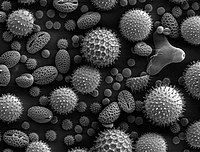
Photo from wikipedia
It has been recently shown that an interferometric measurement may allow for sub-wavelength resolution of incoherent light. Whereas this holds for noiseless detectors, one could expect that the resolution is… Click to show full abstract
It has been recently shown that an interferometric measurement may allow for sub-wavelength resolution of incoherent light. Whereas this holds for noiseless detectors, one could expect that the resolution is in practice limited by signal-to-noise ratio. Here I present an assessment of the ultimate resolution limits that can be achieved using noisy detectors. My analysis indeed indicates that the signal-to-noise ratio represents a fundamental limit to quantum imaging, and the reduced resolution scales with the square root of the signal-to-noise ratio. For example, a signal-to-ratio of $20 dB$ is needed to resolve one order of magnitude below the Rayleigh limit.
Journal Title: Physical Review A
Year Published: 2020
Link to full text (if available)
Share on Social Media: Sign Up to like & get
recommendations!